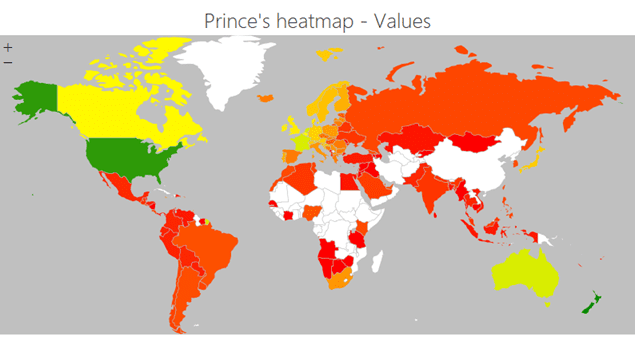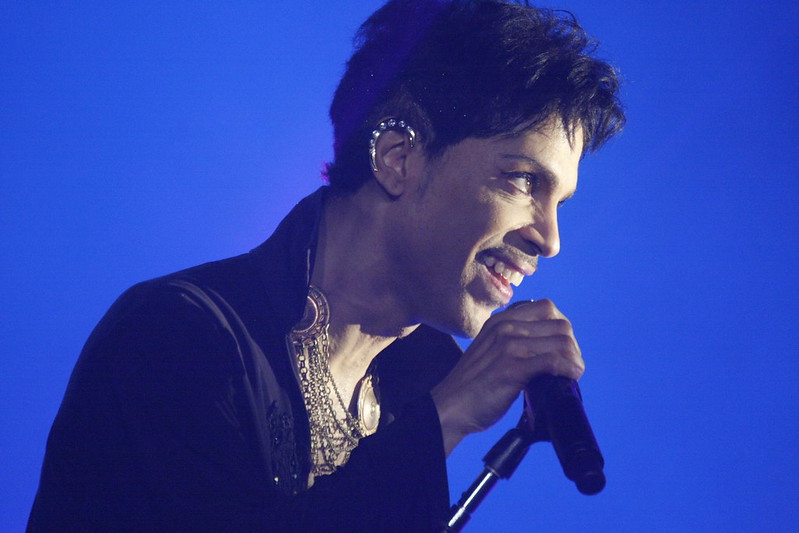Prince’s global heatmap
After his sudden passing in April 21, 2016, Prince shot to the top of iTunes charts in most countries. More than two years later, at the release of his first posthumous album Piano & A Microphone 1983, we wonder if that was due to the bad state of downloads that made it easier to dominate the field or if the icon was truly big everywhere.
His US success is out of question. From the fast Diamond award of the classic album Purple Rainto his countless Top 10 hits, the country proved more than once its support to the kid of Minneapolis. He peaked at the same time as the likes Michael Jackson and Madonna who smashed all around the world. Let’s see if Prince has been able to do the same.
The method
In order to identify on which countries Prince performed well, the way to go is to look at the remaining monster sellers. Thus, we collected market by market YouTube statistics of all Top 5 CSPC artists so far. They are the Beatles, Michael Jackson, Elvis Presley, Madonna and Queen. Then, Adele was also added to get an artist reflective of the current market dynamics. Referenced at the time of their own studies, Meat Loaf, Jennifer Lopez and Frank Sinatra add volume and thus consistency to the scaling group.
As stated inside the article Learn how to exploit YouTube Insights, the absolute number of views is irrelevant. Depending on your target audience and its YouTube usage habits, you will have very different results. Relative results do matter though. That’s why rather than comparing views numbers, we compare the share of views coming from each market for all these artists. For example, both the Beatles and Queen have over 1,6 million monthly views in Japan. Since Queen outperform the Beatles by 3 to 1 globally, that means Japan is a market 3 times more relevant for the Beatles.
Once we defined the strength of each market for scale artists, we calculate their respective average. To continue with our example, our scale artists register 1,70% of their global streams in Japan. Madonna‘s count there stands at 1,56%, it means the relevance of this market is only 92% (1,56%/1,70%) as high for him as for the others.
The results

The greenest a country is, the best Prince performed in comparison to the scale artists. On yellow ones, he still does better than the average. Countries in orange represent mixed performances, the most red they get, the most there is an underperformance. Countries in white fail to appear among personal Top 100 markets on YouTube of all our scale artists.
We aren’t done still. An artist can record a huge chunk of his views in a few countries only, say in the US. That’s precisely the case of Prince who scores over 57% of his views in his native country. His comparative shares in remaining countries would then underperform massively reference values. This issue is known for years in the world of statisticians. A very efficient way to avoid these outliers consists in comparing rankings instead of raw values. As a result, instead of saying that Prince outperforms the scale by 2,38 to 1 in New-Zealand, we will say that New-Zealand is the country of rank 1, the one where he performs the best relatively speaking.

The greenest a country is, the highest it is among Prince‘s top markets and so on until red markets.
The analysis
The values map is obviously massively impacted by the strong success of the artist in the US. That slows down results from virtually everywhere else. He still does well in historical English-speaking markets like the New-Zealand, Australia, the UK and Canada. Maybe more surprisingly, his statistics are huge in France too, actually his best European market, ahead of the aforementioned UK. We already pointed out that he sold very well on that market before his passing.
In the other side, we can see very bad results from both Latin America and Asia. Close to no data ever came out about his sales in these regions, now we can understand that it is simply due to them being low. We can also see how risky it can be to gauge Asian success through Japanese sales figures. That country is his 15th best market with a relative strength of 0,92. The next Asian market is Hong Kong which ranks with half the impact of Japan at 0,46. The average strength of Asian markets besides Japan is as low as 0,25.
The Mexican culture may be growing in the US, a success in the latter country doesn’t grant good figures in the former. Prince‘s strength in both markets is 0,19 and 2,19, respectively, a 11 to 1 gap.
The rank map does illustrate a consistent appeal in almost all European countries. The singer does extremely well in France, very well in Benelux, well in the UK, Ireland and Scandinavia and good to decent in the rest of the continent.
If you are more of a number guy, below is the list of countries with both values and ranks.

